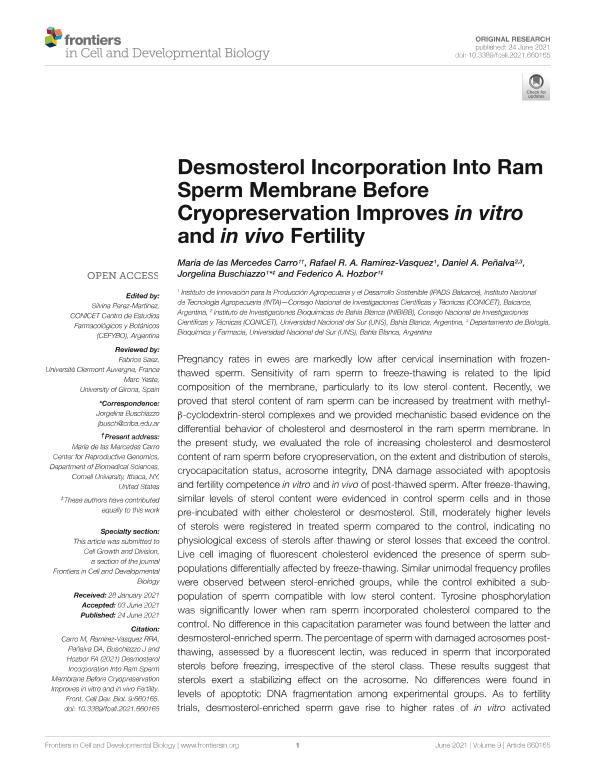Artículo
Desmosterol Incorporation Into Ram Sperm Membrane Before Cryopreservation Improves in vitro and in vivo Fertility
Carro, Maria de Las Mercedes ; Ramírez Vasquez, Rafael Ramón Alejandro
; Ramírez Vasquez, Rafael Ramón Alejandro ; Peñalva, Daniel Alejandro
; Peñalva, Daniel Alejandro ; Buschiazzo, Jorgelina
; Buschiazzo, Jorgelina ; Hozbor, Federico Andrés
; Hozbor, Federico Andrés
 ; Ramírez Vasquez, Rafael Ramón Alejandro
; Ramírez Vasquez, Rafael Ramón Alejandro ; Peñalva, Daniel Alejandro
; Peñalva, Daniel Alejandro ; Buschiazzo, Jorgelina
; Buschiazzo, Jorgelina ; Hozbor, Federico Andrés
; Hozbor, Federico Andrés
Fecha de publicación:
24/06/2021
Editorial:
Frontiers Media
Revista:
Frontiers in Cell and Developmental Biology
e-ISSN:
2296-634X
Idioma:
Inglés
Tipo de recurso:
Artículo publicado
Clasificación temática:
Resumen
Pregnancy rates in ewes are markedly low after cervical insemination with frozen-thawed sperm. Sensitivity of ram sperm to freeze-thawing is related to the lipid composition of the membrane, particularly to its low sterol content. Recently, we proved that sterol content of ram sperm can be increased by treatment with methyl-β-cyclodextrin-sterol complexes and we provided mechanistic based evidence on the differential behavior of cholesterol and desmosterol in the ram sperm membrane. In the present study, we evaluated the role of increasing cholesterol and desmosterol content of ram sperm before cryopreservation, on the extent and distribution of sterols, cryocapacitation status, acrosome integrity, DNA damage associated with apoptosis and fertility competence in vitro and in vivo of post-thawed sperm. After freeze-thawing, similar levels of sterol content were evidenced in control sperm cells and in those pre-incubated with either cholesterol or desmosterol. Still, moderately higher levels of sterols were registered in treated sperm compared to the control, indicating no physiological excess of sterols after thawing or sterol losses that exceed the control. Live cell imaging of fluorescent cholesterol evidenced the presence of sperm sub-populations differentially affected by freeze-thawing. Similar unimodal frequency profiles were observed between sterol-enriched groups, while the control exhibited a sub-population of sperm compatible with low sterol content. Tyrosine phosphorylation was significantly lower when ram sperm incorporated cholesterol compared to the control. No difference in this capacitation parameter was found between the latter and desmosterol-enriched sperm. The percentage of sperm with damaged acrosomes post-thawing, assessed by a fluorescent lectin, was reduced in sperm that incorporated sterols before freezing, irrespective of the sterol class. These results suggest that sterols exert a stabilizing effect on the acrosome. No differences were found in levels of apoptotic DNA fragmentation among experimental groups. As to fertility trials, desmosterol-enriched sperm gave rise to higher rates of in vitro activated oocytes by heterologous fertilization and to significantly lower pregnancy loss in vivo. Our research provides new insights on sterol incorporation into ram sperm prior to cryopreservation, in particular on the additional benefit of incorporating desmosterol as a strategy to improve fertility outcome.
Palabras clave:
CRYOPRESERVATION
,
OVINE SPERM
,
CHOLESTEROL
,
DESMOSTEROL
,
ARTIFICIAL INSEMINATION
Archivos asociados
Licencia
Identificadores
Colecciones
Articulos (IPADS BALCARCE)
Articulos de INSTITUTO DE INNOVACIÓN PARA LA PRODUCCIÓN AGROPECUARIA Y EL DESARROLLO SOSTENIBLE
Articulos de INSTITUTO DE INNOVACIÓN PARA LA PRODUCCIÓN AGROPECUARIA Y EL DESARROLLO SOSTENIBLE
Articulos(INIBIBB)
Articulos de INST.DE INVEST.BIOQUIMICAS BAHIA BLANCA (I)
Articulos de INST.DE INVEST.BIOQUIMICAS BAHIA BLANCA (I)
Citación
Carro, Maria de Las Mercedes; Ramírez Vasquez, Rafael Ramón Alejandro; Peñalva, Daniel Alejandro; Buschiazzo, Jorgelina; Hozbor, Federico Andrés; Desmosterol Incorporation Into Ram Sperm Membrane Before Cryopreservation Improves in vitro and in vivo Fertility; Frontiers Media; Frontiers in Cell and Developmental Biology; 9; 24-6-2021; 660165
Compartir
Altmétricas



